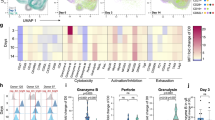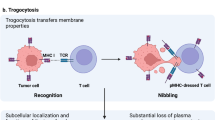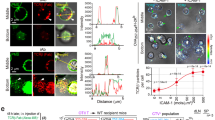Abstract
THE recent generation of perform knock-out mice1,2 has demonstrated a crucial role for the pore-forming perforin in cytolytic T-lymphocyte (CTL)-mediated cytolysis. Perforin-deficient mice failed to clear lymphocytic choriomeningitis virus in vivo, yet substantial killing activity still remained in perforin-free CTLs in vitro, indicating the presence of (a) further lytic pathway(s). Fas is an apoptosis-signalling receptor molecule on the surface of a number of different cells. Here we report that both perforin-deficient and Fas-ligand-deficient CTLs show impaired lytic activity on all target cells tested. The killing activity was completely abolished when both pathways were inactivated by using target cells from Fas-receptor-deficient lpr mice and perforin-free CTL effector cells. Fas-ligand-based killing activity was triggered upon T-cell receptor occupancy and was directed to the cognate target cell. Thus, two complementary, specific cytotoxic mechanisms are functional in CTLs, one based on the secretion of lytic proteins and one which depends on cell-surface ligand–receptor interaction.
This is a preview of subscription content, access via your institution
Access options
Subscribe to this journal
Receive 51 print issues and online access
$199.00 per year
only $3.90 per issue
Buy this article
- Purchase on SpringerLink
- Instant access to full article PDF
Prices may be subject to local taxes which are calculated during checkout
Similar content being viewed by others
References
Kägi, D. et al. Nature 369, 31–37 (1994).
Lowin, B., Beermann, F., Schmidt, A. & Tschopp, J. Proc. natn. Acad. Sci. U.S.A. (in the press).
Itoh, N. et al. Cell 66, 233–243 (1991).
Trauth, B. C. et al. Science 245, 301–305 (1989).
Itoh, N., Tsujimoto, Y. & Nagata, S. J. exp. Med. 178, 461–468 (1993).
Takahashi, T. et al. Cell 76, 969–976 (1994).
Ramsdell, F. et al. Eur. J. Immun. 24, 928–933 (1994).
Vignaux, F. & Golstein, P. Eur. J. Immun. 24, 923–927 (1994).
Rouvier, E., Luciani, M. F. & Golstein, P. J. exp. Med. 177, 195–200 (1993).
Cerottini, J. C., Engers, H. D., MacDonald, H. R. & Brunner, T. J. exp. Med. 140, 703–717 (1974).
Kupfer, A., Singer, S. J. & Dennert, G. J. exp. Med. 163, 489–498 (1986).
Peters, P. et al. Eur. J. Immun. 19, 1469–1475 (1989).
Russell, J. H., Rush, B., Weaver, C. & Wang, R. Proc. natn. Acad. Sci. U.S.A. 90, 4409–4413 (1993).
Suda, T., Takahashi, T., Golstein, P. & Nagata, S. Cell 75, 1169–1178 (1993).
Ogasawara, J. et al. Nature 364, 806–809 (1993).
Tschopp, J., Schafer, S., Masson, D., Peitsch, M. C. & Heusser, C. Nature 337, 272–274 (1989).
Coligan, J. E. Current Protocols in Immunology 3121–3126 (Wiley-lnterscience, New York, 1992).
Maryanski, J. L., MacDonald, H. R. & Cerottini, J. C. J. Immun. 124, 42–48 (1980).
Ucker, D. S. et al. Molec. cell. Biol. 12, 3060–3069 (1992).
Author information
Authors and Affiliations
Rights and permissions
About this article
Cite this article
Lowin, B., Hahne, M., Mattmann, C. et al. Cytolytic T-cell cytotoxicity is mediated through perforin and Fas lytic pathways. Nature 370, 650–652 (1994). https://doi.org/10.1038/370650a0
Received:
Accepted:
Issue Date:
DOI: https://doi.org/10.1038/370650a0



